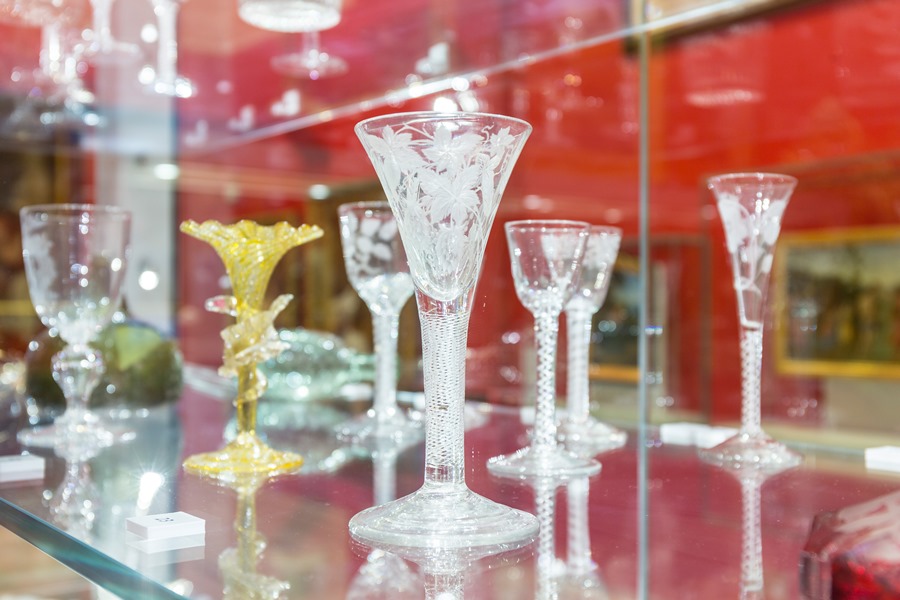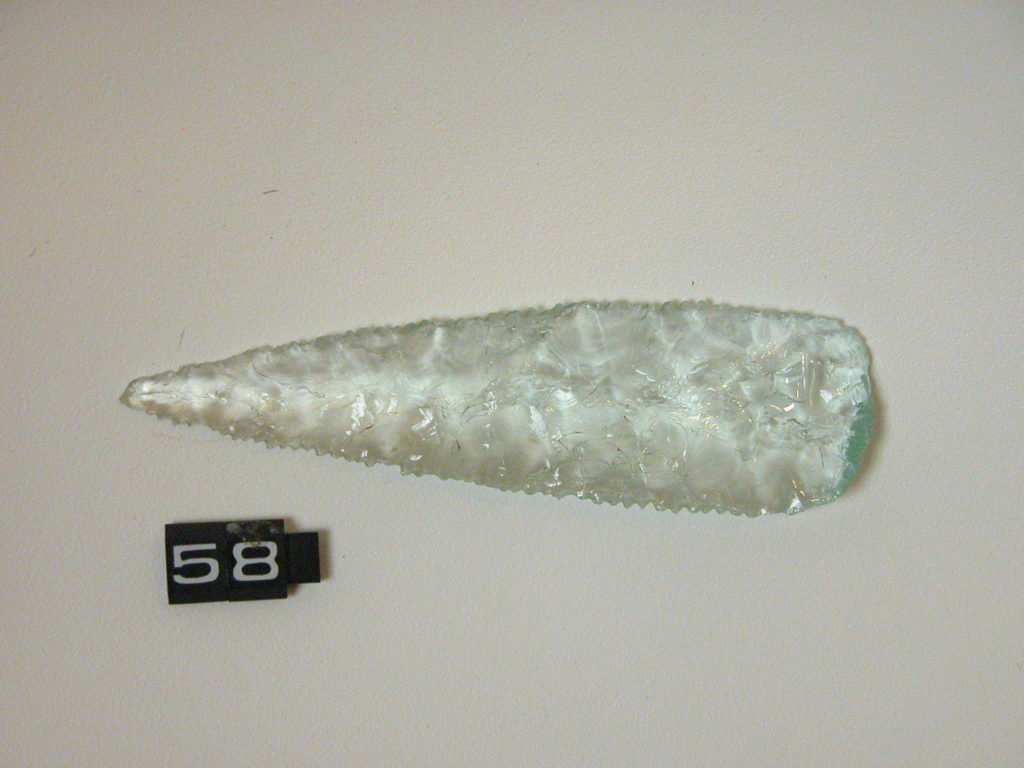
Aboriginal arrowhead
Made from the glass of a discarded bottle.
Reference: CANCM:nn
Can be found: Lower shelfMaterials and Masters

Base of a pale blue glass vessel with fluted pattern
Reference: 2602
Can be found: BaseMaterials and Masters

Blue beads
Beads made from blue, red and ‘milles feuilles’ glass.
Reference: CANCM:nn
Can be found: Lower shelfMaterials and Masters
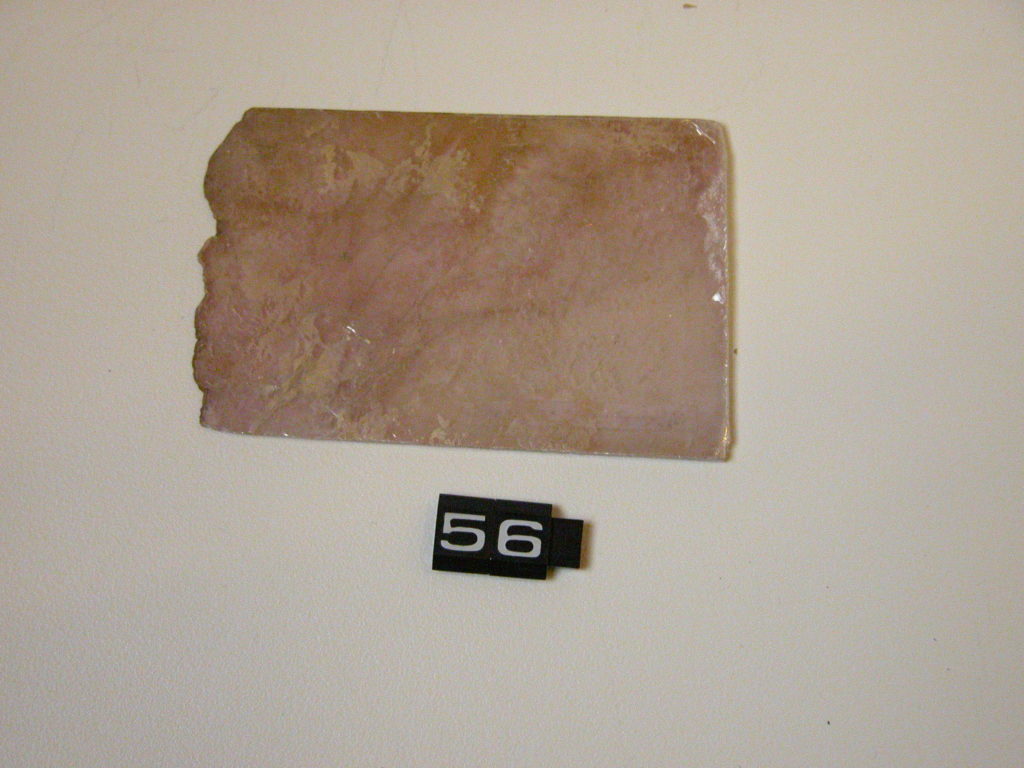
Carnival glass
Decorative coloured drinking glasses are known as Carnival Glass.
Bequeathed by Miss Frances Aitken, 1992
Reference: 1992.1.151
Can be found: Centre shelfMaterials and Masters
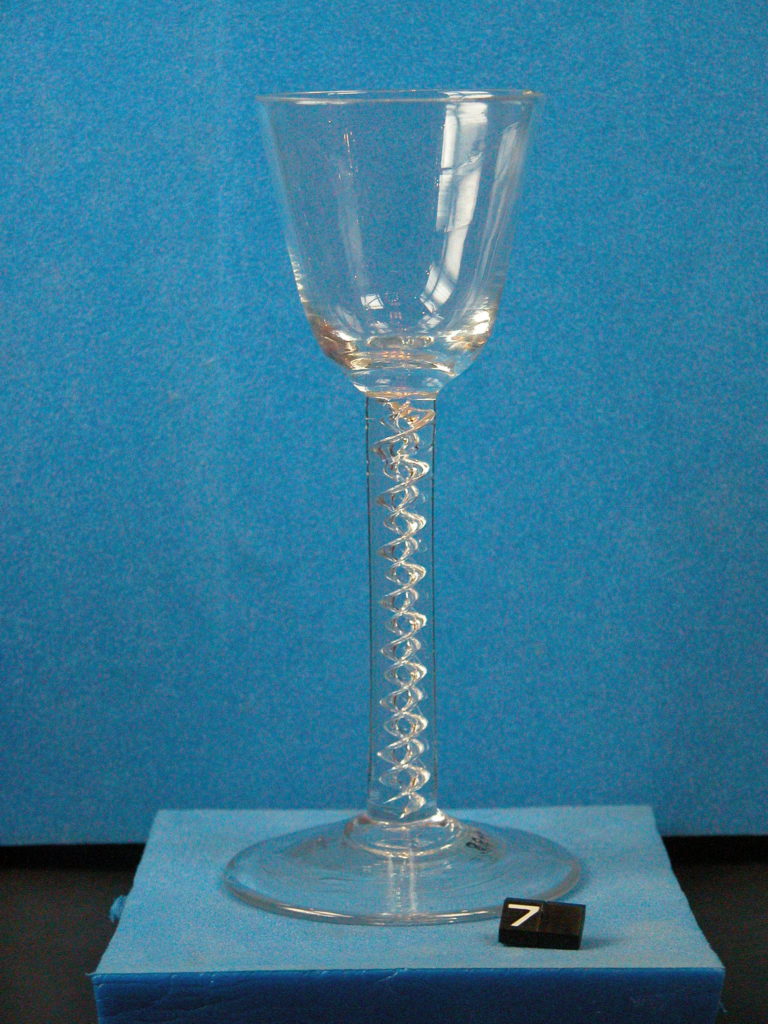
Cordial glass
18th century
With plain bowl and air twist stem.
Bequeathed by John Irving, 1915
Reference: 8644
Can be found: Centre shelfMaterials and Masters
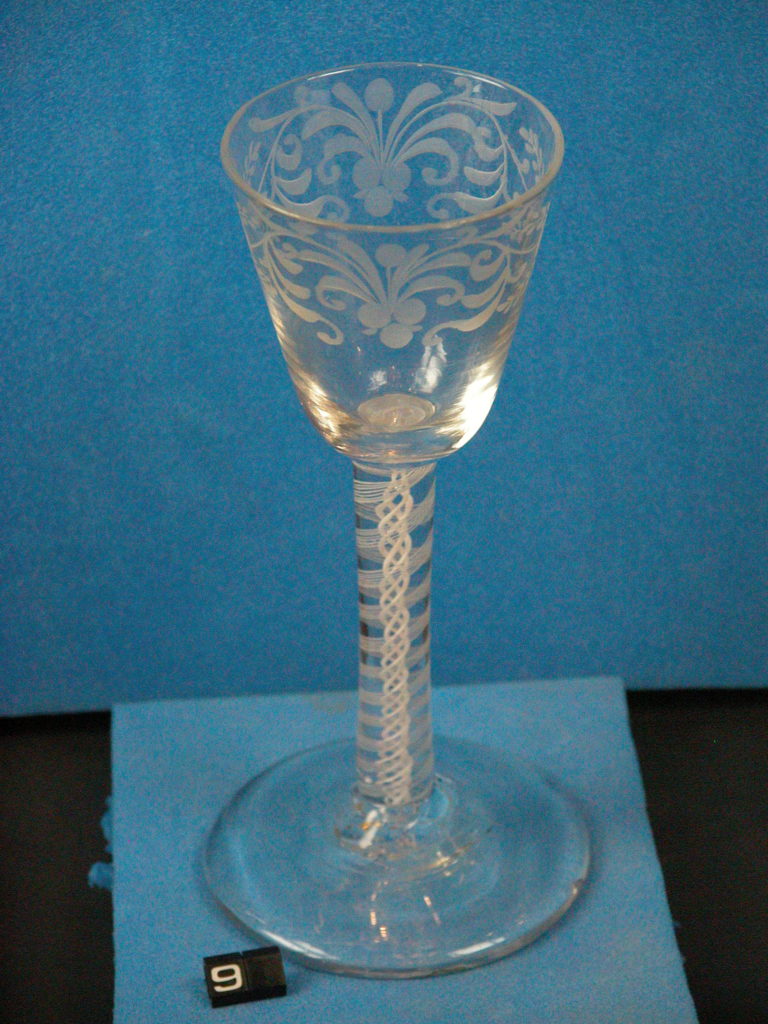
Cordial glass
18th century
With engraved decoration and opaque twist stem.
Bequeathed by John Irving, 1915
Reference: 5576
Can be found: Centre shelfMaterials and Masters
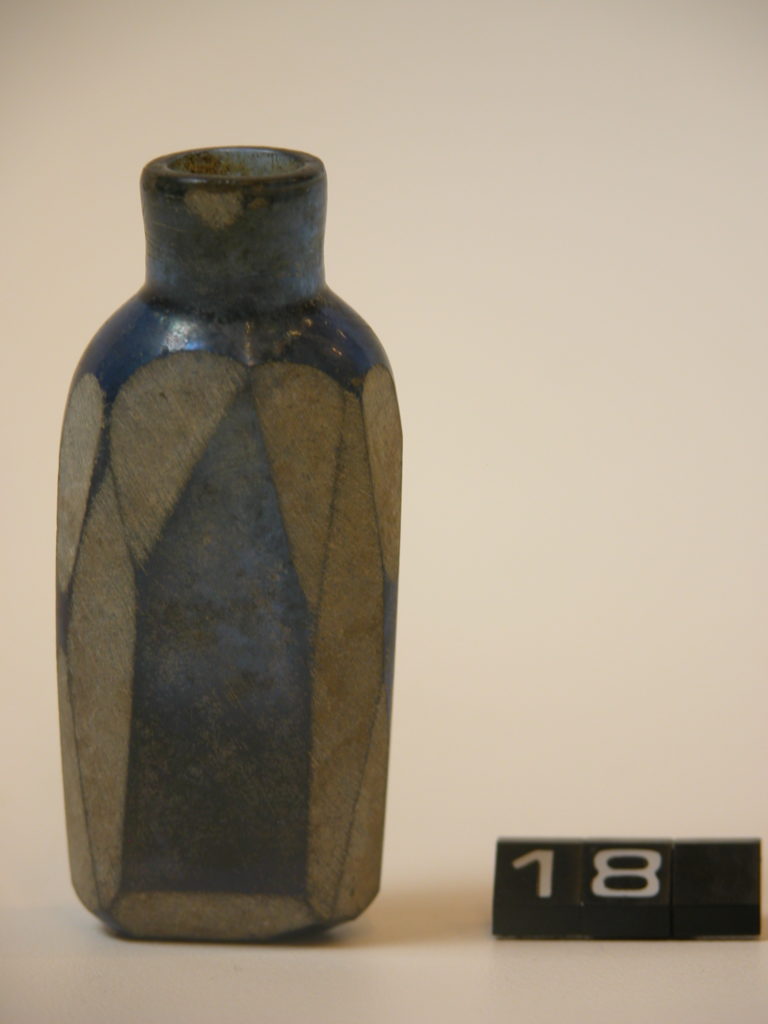
Dark blue bottle with ground bevelled edges
Presented by John Brent
Reference: 2458
Can be found: BaseMaterials and Masters

Dolls house glass and miniature perfume sample bottles
Bequeathed by Miss G H Veraguth to the daughter of Dr Wynn and presented to the Museum in memory of Miss Veraguth, 1974
Reference: 9870
Can be found: Lower shelfMaterials and Masters
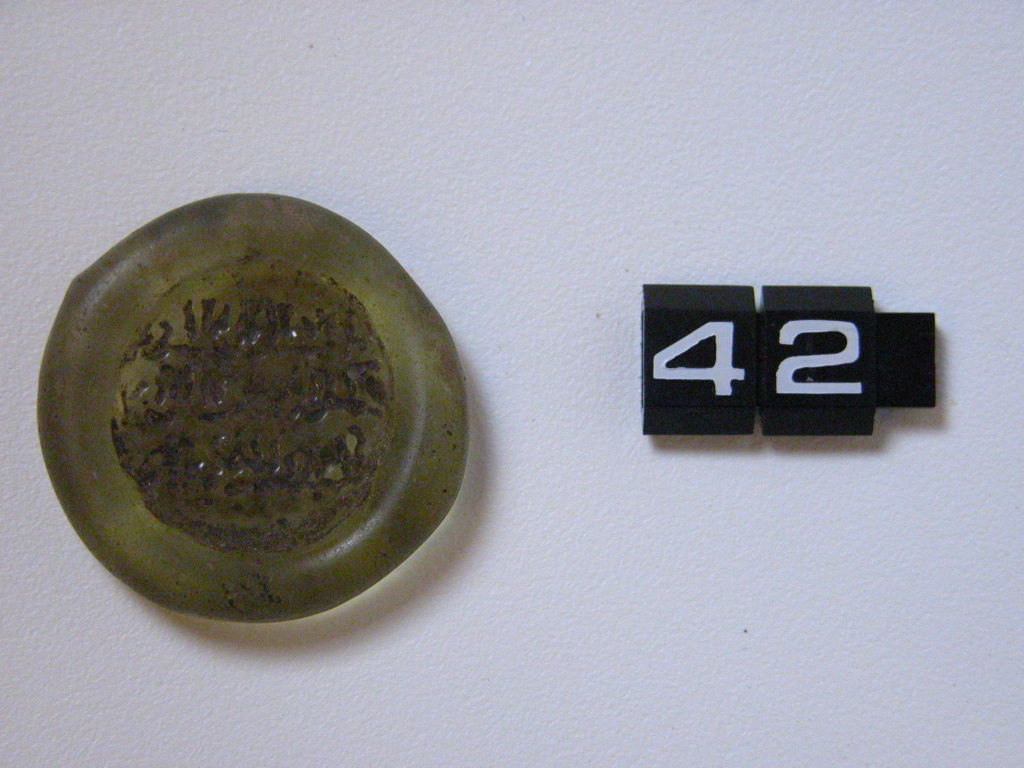
Egyptian buttons or counters and money weight
Glass buttons or counters found in Egypt. The ancient Egyptians were the first to make coloured glass objects.
Several presented by Lt Col Copeland
Reference: 2100, 2039, (nn)
Can be found: Lower shelfMaterials and Masters
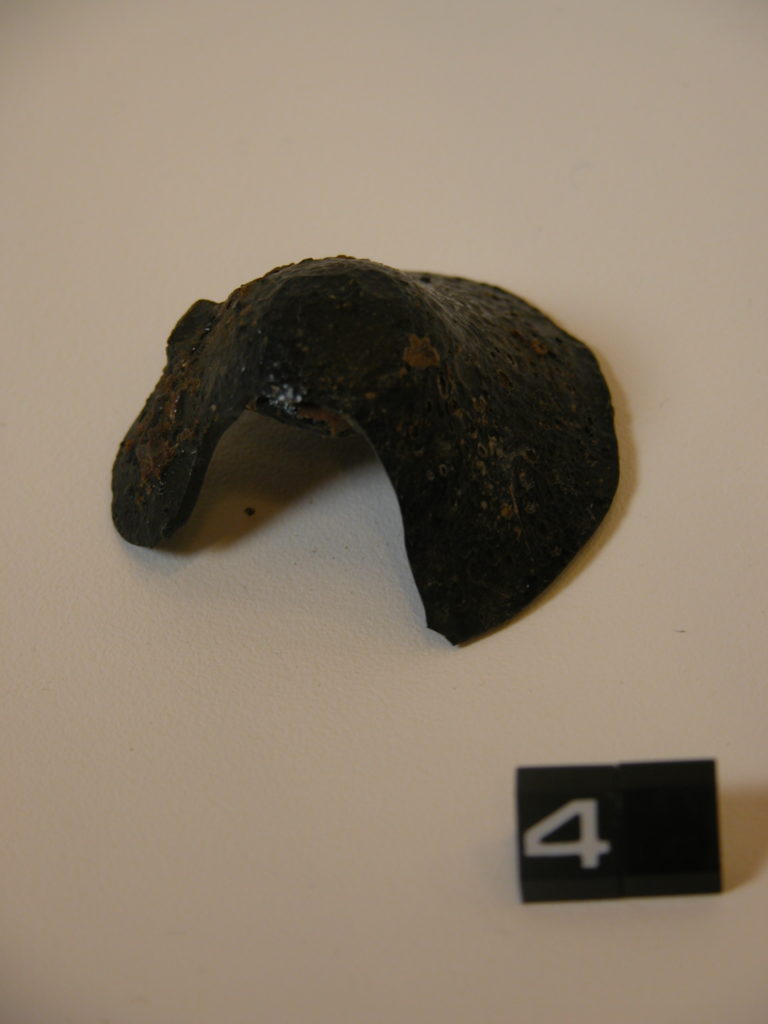
Fragment of a thin-walled black glass vessel, probably a bowl
Reference: 2480
Can be found: BaseMaterials and Masters

Fragment of multi-coloured glass
Reference: 2598
Can be found: BaseMaterials and Masters
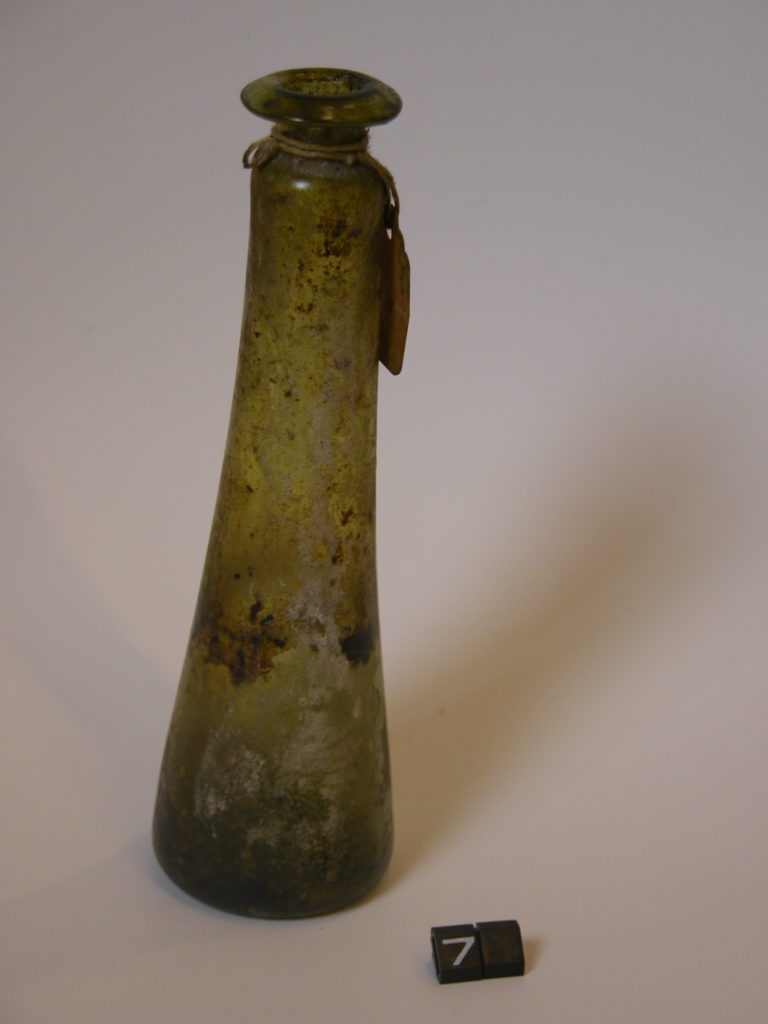
Glass phial containing wood(?)
Bequeathed by John Brent
Reference: 2290
Can be found: BaseMaterials and Masters

Glass slag
A lump of glass made from molten Silica.
Reference: MDB.499
Can be found: Lower shelfMaterials and Masters

Glasses and pinces-nez
Glasses can be made to sit on the nose, without earpieces. Such glasses are known as pinces-nez – literally ‘nose pinchers’.
Pince-nez bequeathed by Miss Frances Aitken, 1992
Reference: 1992.1.133-4
Can be found: Centre shelfMaterials and Masters
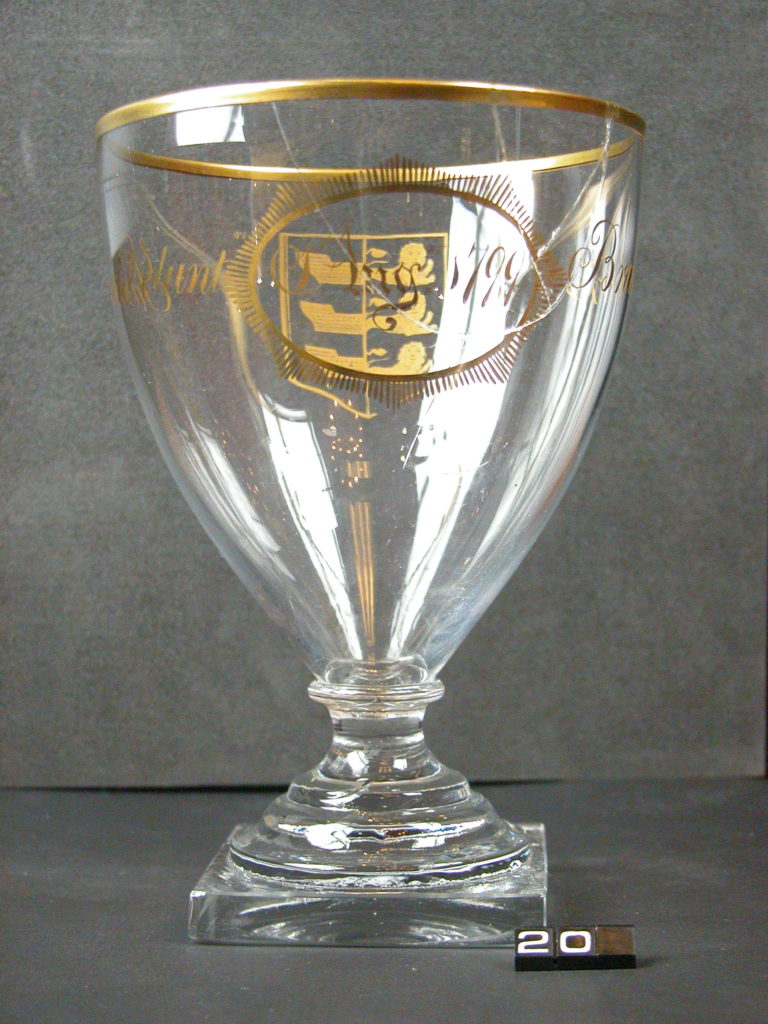
Goblet
1799
With gilded coat of arms and the wording ‘Sandwich Volunteer Aug 1799 Brave and Free’.
Presented by Miss B Street from her brother’s collection, 1933
Reference: CANCM:nn
Can be found: Materials and MastersTop shelf
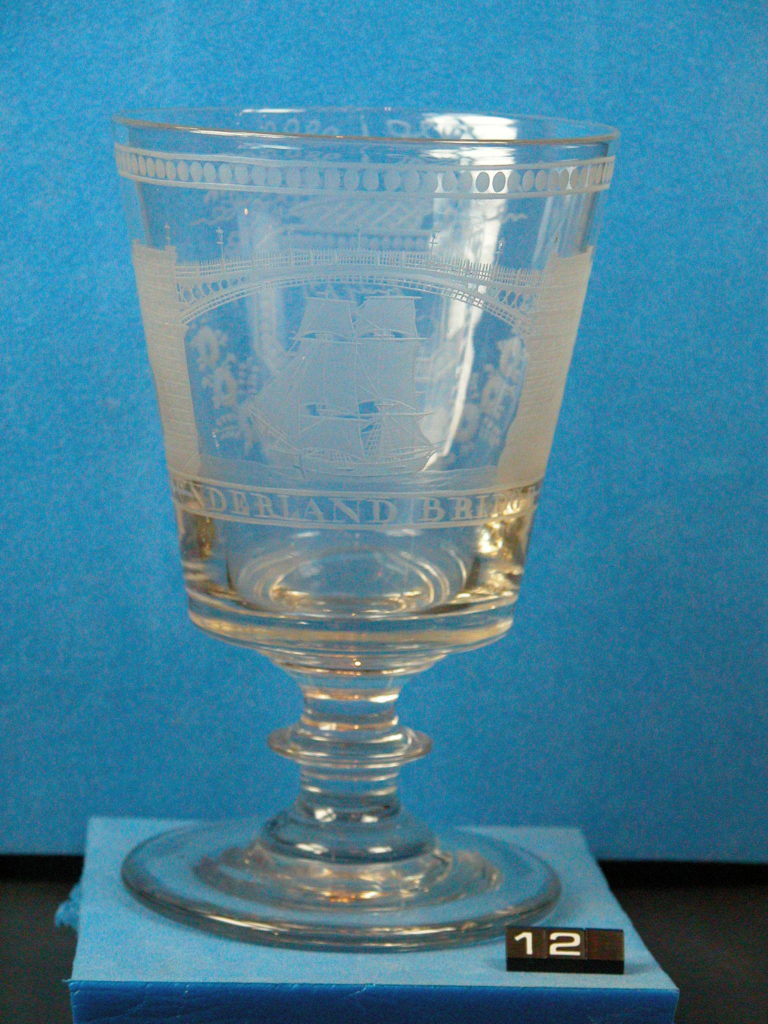
Goblet
18th century
Engraved with initials and an image of Sunderland Bridge, with a ship passing below it.
Bequeathed by John Irving, 1915
Reference: 5580
Can be found: Materials and MastersTop shelf
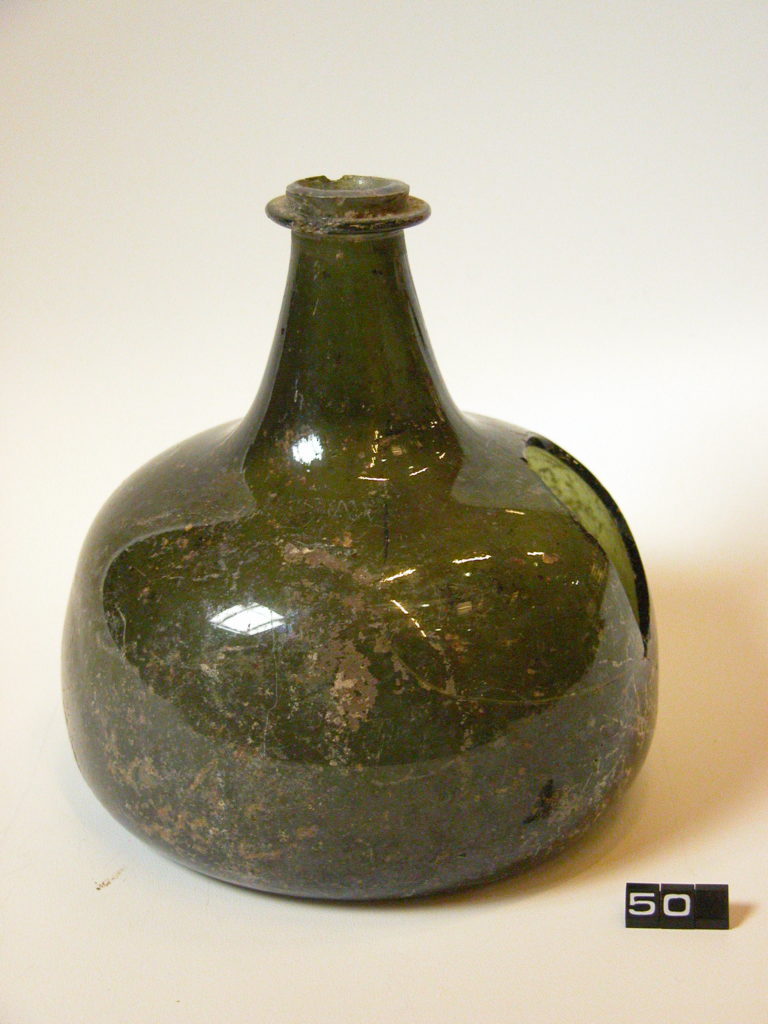
Green bottle
Bottles like this are often found with holes in a similar place. Recent research has suggested that the holes were made by collectors who broke off the seals on bottles as the broken areas correspond to where seals would have been located.
Reference: CANCM:nn
Can be found: Centre shelfMaterials and Masters
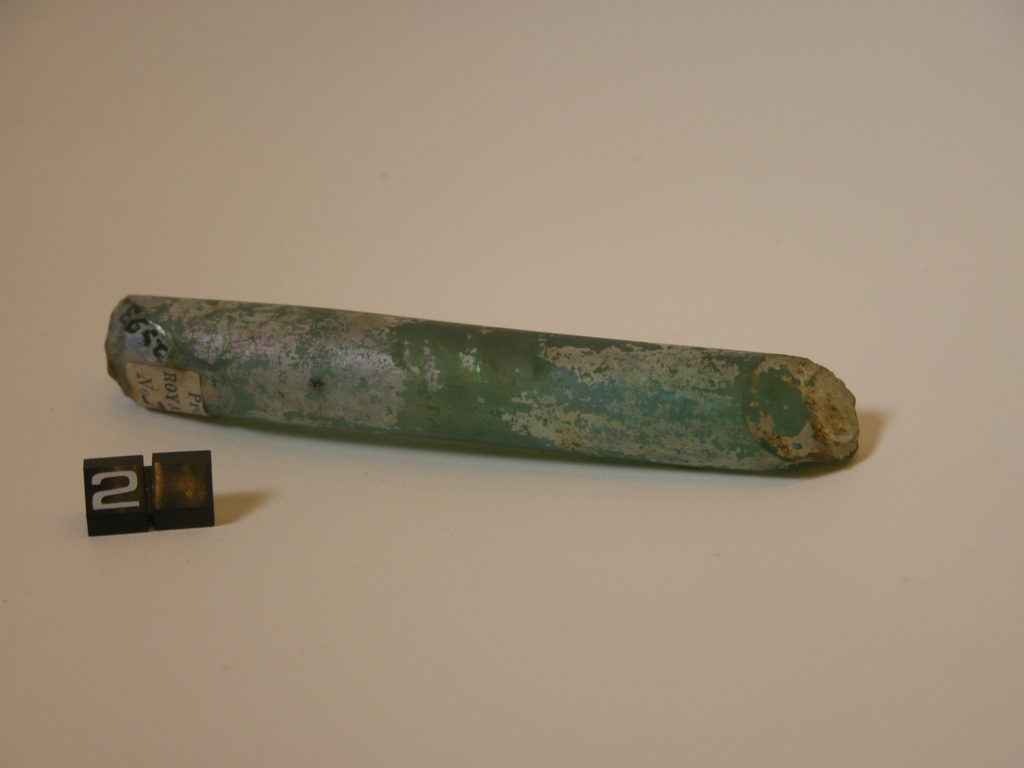
Green glass rod
Reference: 2593
Can be found: BaseMaterials and Masters
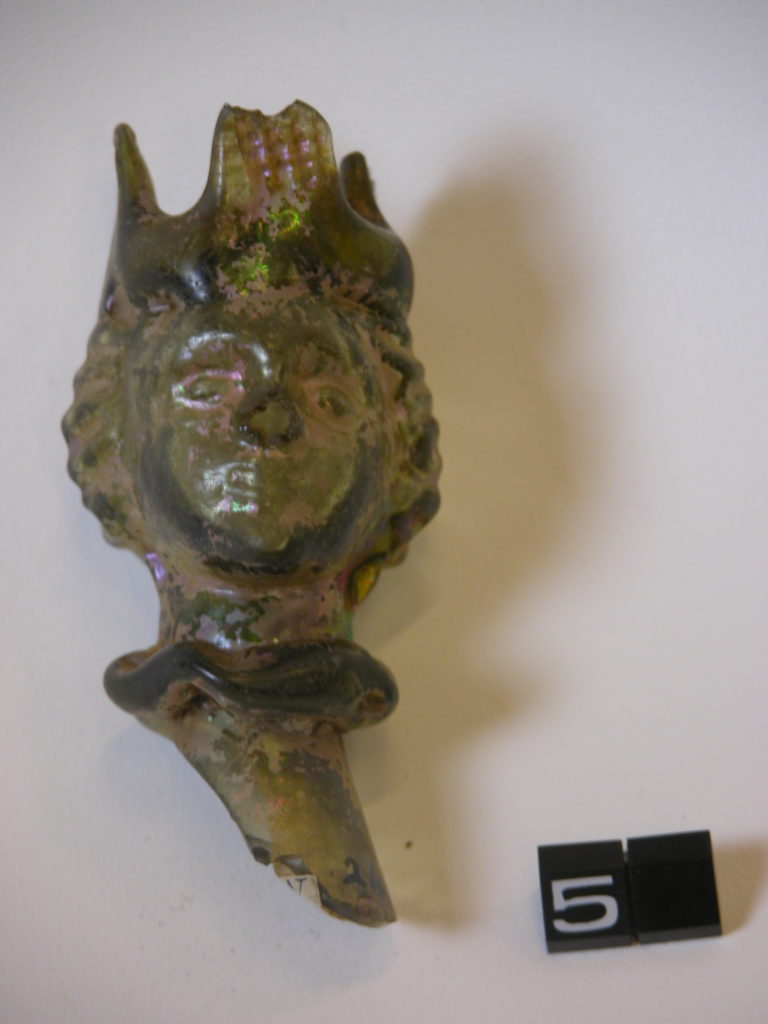
Head of a female wearing a crown
The glass is hollow and would have been blown into a mould.
Reference: 2499
Can be found: BaseMaterials and Masters

Jacobite wine glass
18th century
Engraved with the Jacobite rose and a butterfly, and having an opaque twist stem.
Bequeathed by John Irving, 1915
Reference: 5579
Can be found: Centre shelfMaterials and Masters
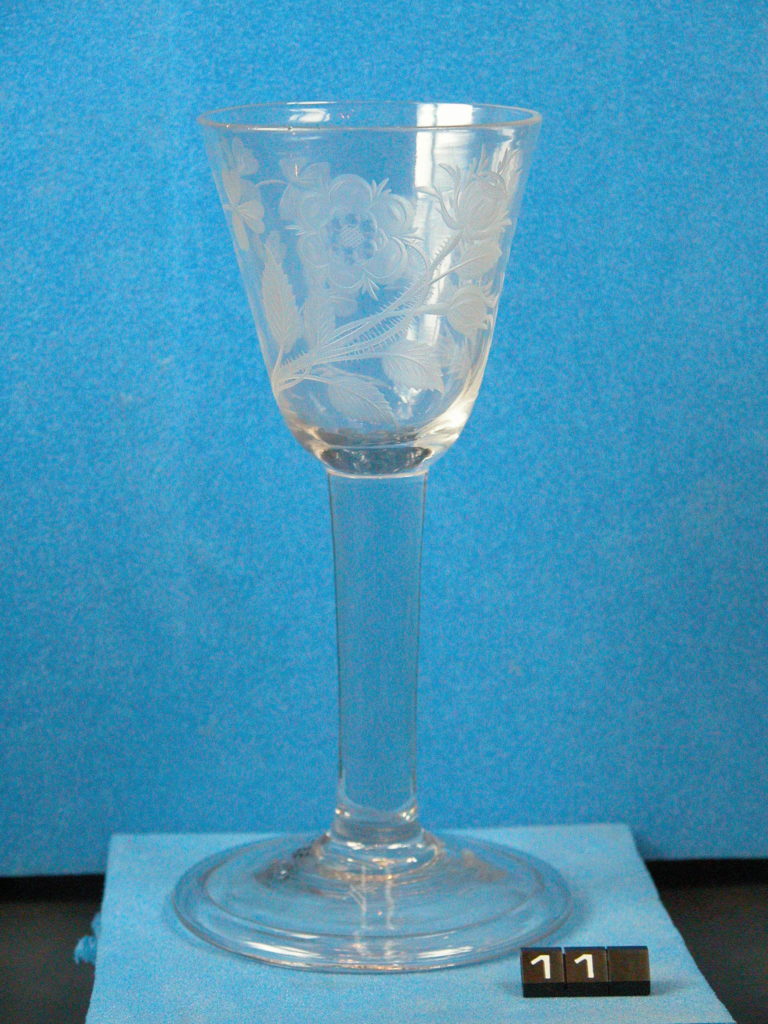
Jacobite wine glass
1745 – 70
Engraved with the Jacobite rose and having a plain stem.
Bequeathed by John Irving, 1915
Reference: 5573
Can be found: Centre shelfMaterials and Masters

Lantern slides
Glass slides with images painted on them, which were projected large by shining a light through the slides using an early form of projector.
Bequeathed by Miss Frances Aitken, 1992
Reference: 1992.1.151
Can be found: Centre shelfMaterials and Masters
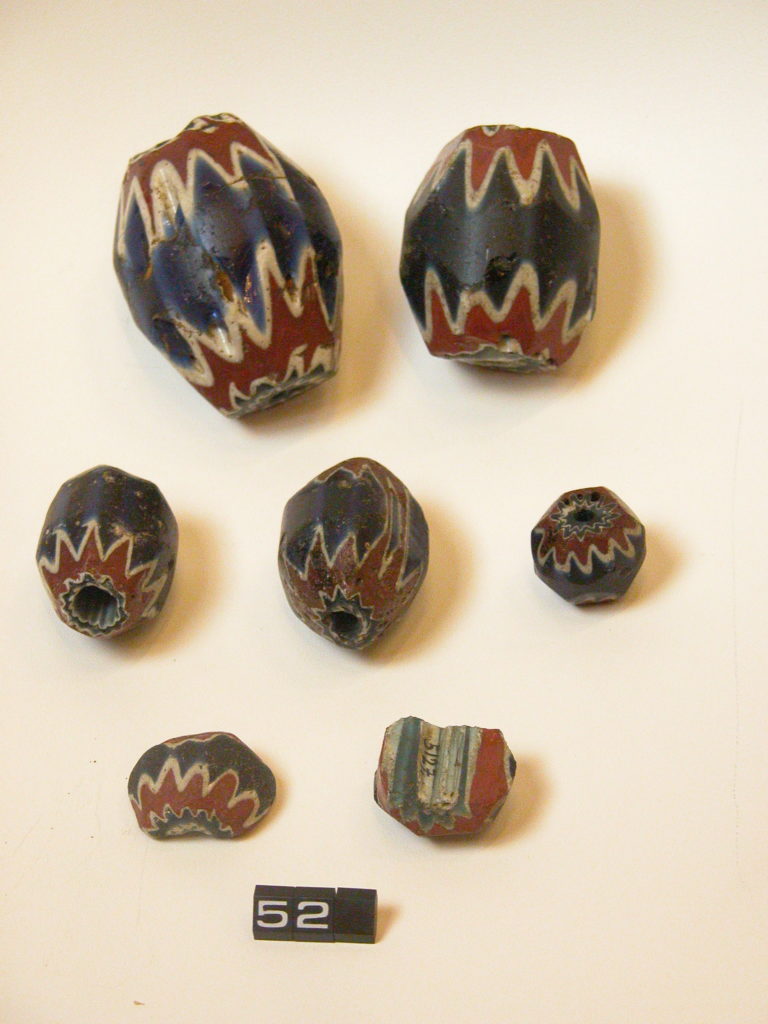
Large blue beads with chevron patterns
These beads are of unknown date and have been variously described as Egyptian, Medieval and Renaissance. The two halves of bead show how the colours are added by progressive dipping and coating.
Several presented by Lt Col Copeland and John Brent
Reference: 2131, 1983, 1982, 2607, 2613, 1998, 5127
Can be found: Lower shelfMaterials and Masters
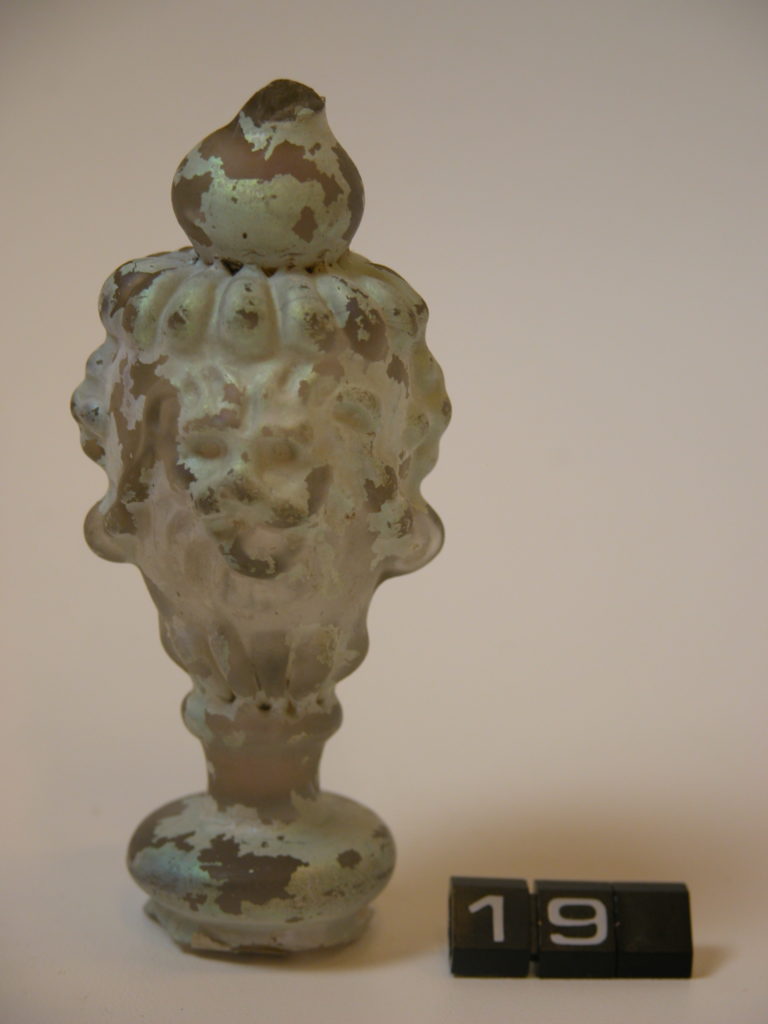
Lion’s head, part of a vase or glass
The glass is hollow and would have been blown into a mould.
Reference: 2603
Can be found: BaseMaterials and Masters
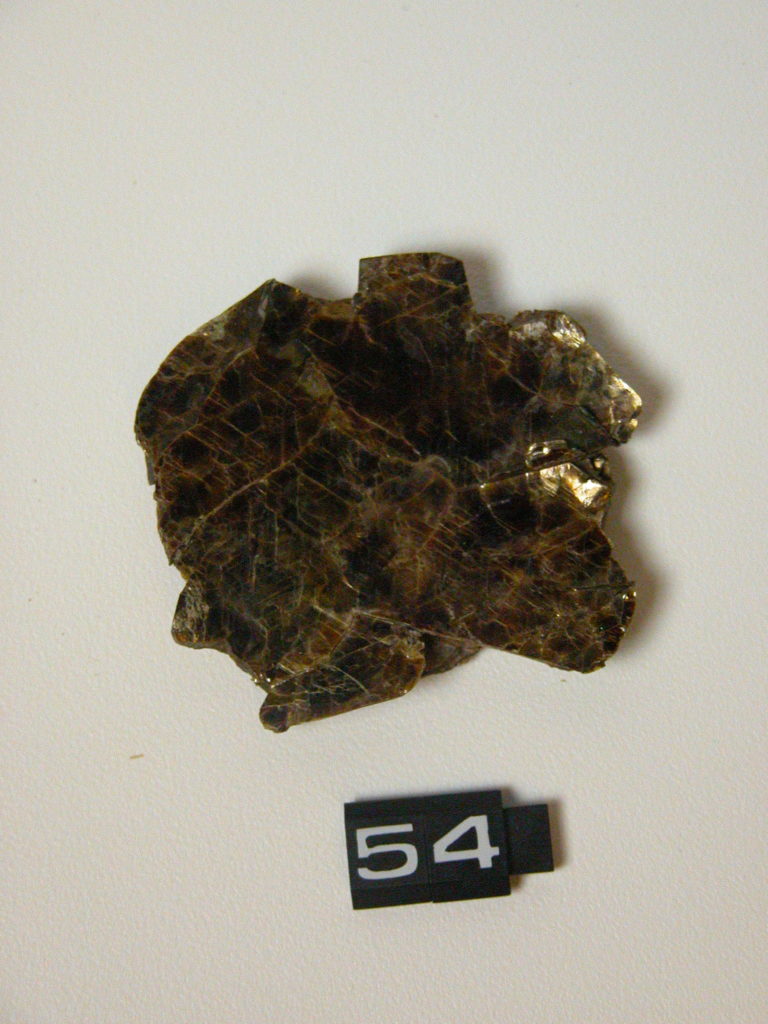
Mica
The mineral Mica is a Silicate that forms in very thin layers; the single sheet shows how transparent it can be. It was known as Muscovy Glass. Mica is mainly white but there is a black variety containing iron.
Reference: O.I.24, D4.B468, 2006.25, D4.B470, (nn)
Can be found: Lower shelfMaterials and Masters

Milles feuilles brooches
Coloured opaque glass can be used to fill small compartments of metal objects, and is known as enamel. Decoration using tiny compartments is known as milles feuilles – French for millions of leaves.
Reference: 1995.17.1-2
Can be found: Lower shelfMaterials and Masters

Olive green conical glass bottle
Reference: CANCM:nn
Can be found: BaseMaterials and Masters
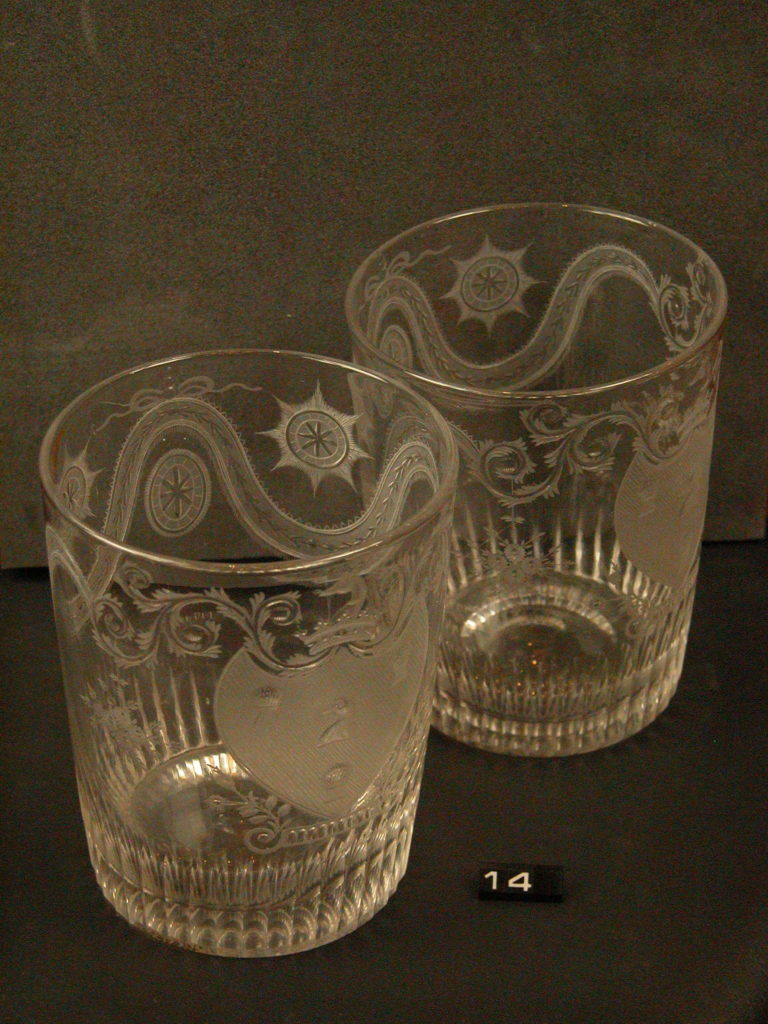
Pair of tumblers
19th century
Engraved with coats of arms and symbols.
Presented by Miss B Street from her brother’s collection, 1933
Reference: 5587, 5588
Can be found: Materials and MastersTop shelf

Pale green glass bottle
Reference: 899
Can be found: BaseMaterials and Masters

Part of the neck of a large Roman bottle
Reference: 821
Can be found: BaseMaterials and Masters
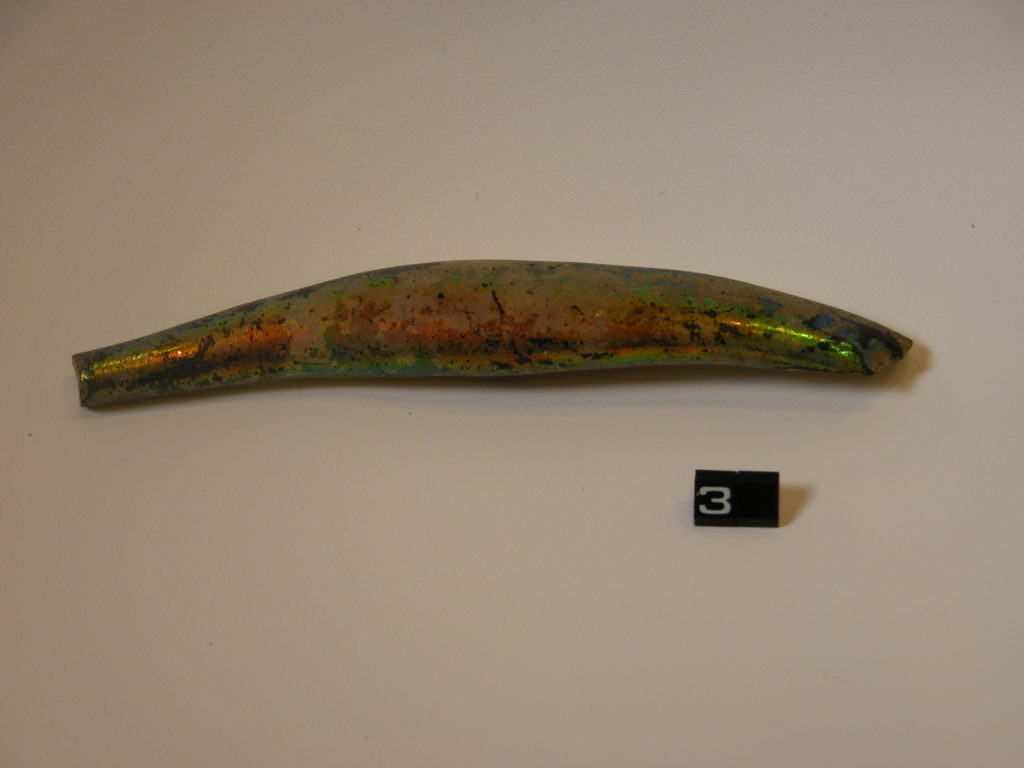
Piece of thick iridescent glass
Reference: 2500
Can be found: BaseMaterials and Masters
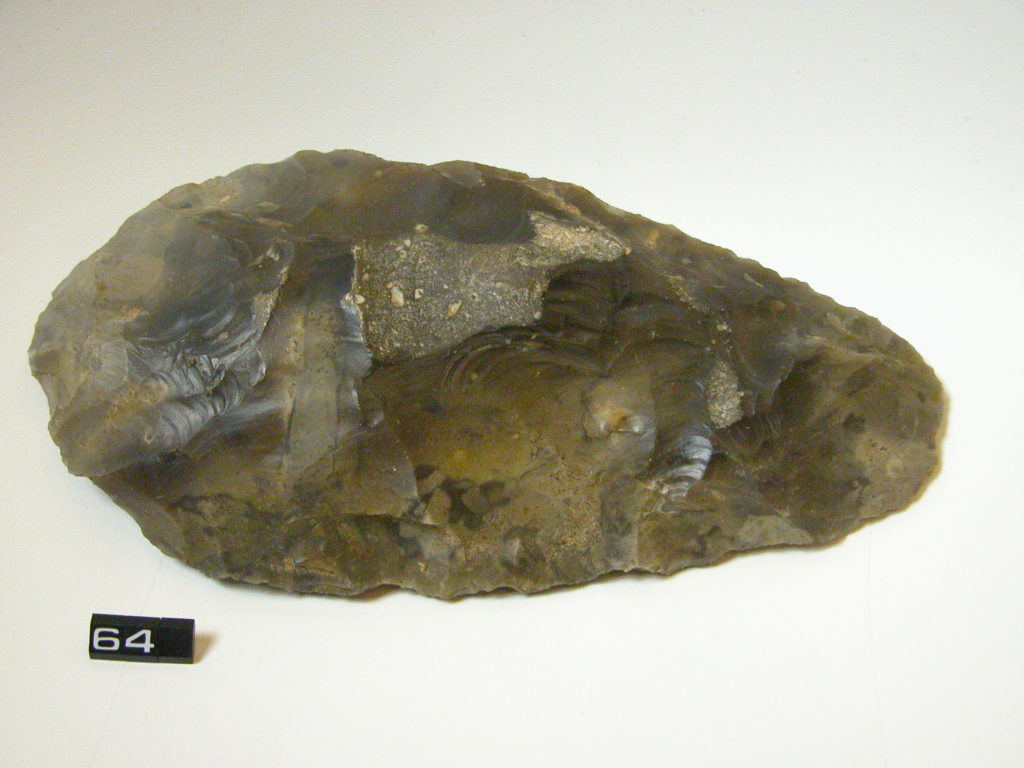
Prehistoric flint hand-axe
Flint is a variety of quartz. It is strong and heavy but can also be chipped away to create very fine sharp edges.
Reference: 430.L.1963/4
Can be found: Lower shelfMaterials and Masters
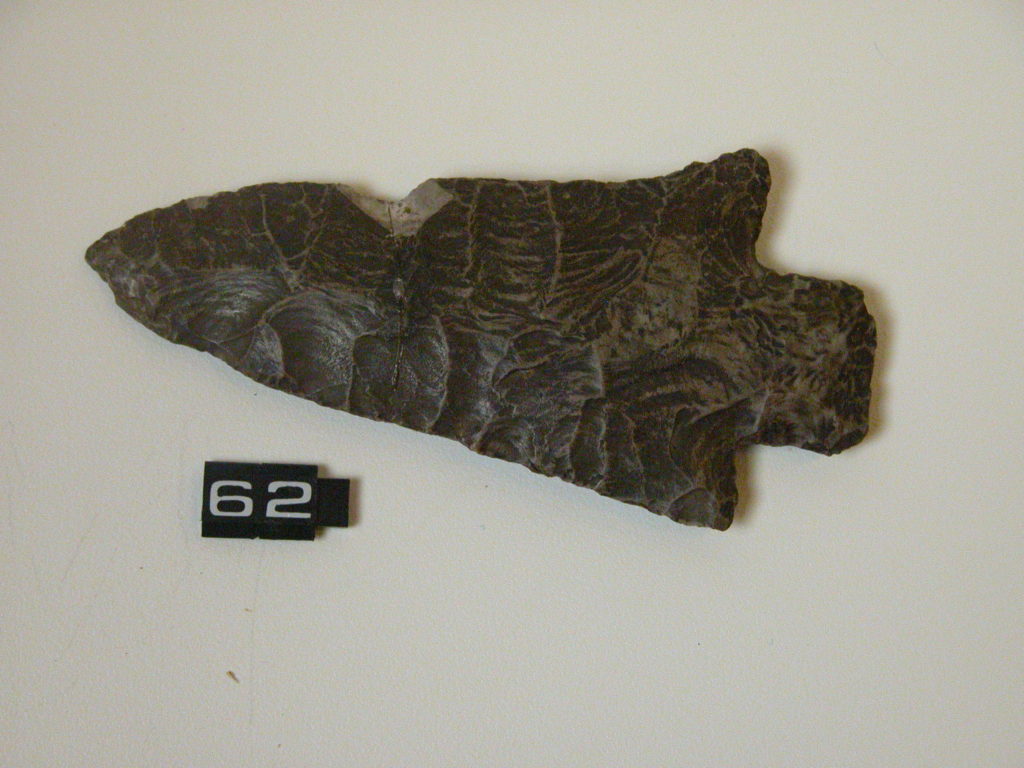
Prehistoric flint lance head, knife and spearheads
Flint is a variety of quartz. It is strong and heavy but can also be chipped away to create very fine sharp edges, sometimes serrated, as in these examples.
Several presented by Lt Col Copeland
Reference: 296, 764, 396, 394
Can be found: Lower shelfMaterials and Masters

Rock crystal
Quartz is a silicate that can form large clear crystals, known as Rock Crystal, or dark opaque lumps, known as Flint.
Reference: CANCM:nn
Can be found: Lower shelfMaterials and Masters
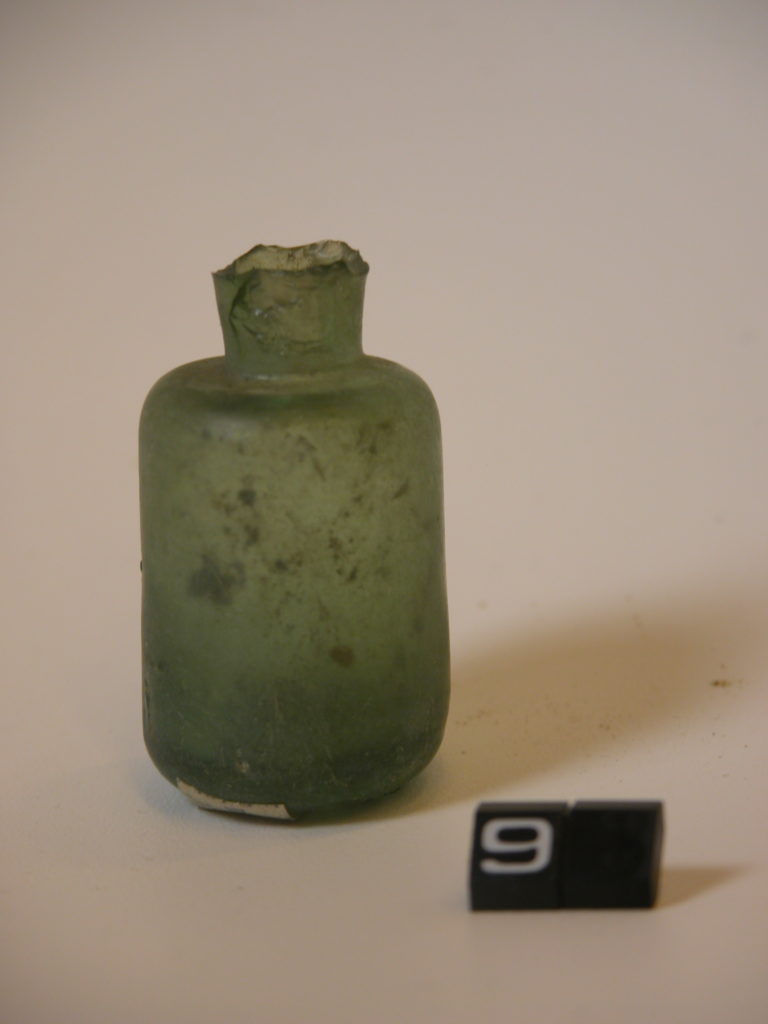
Roman blue and green glass bottles
Reference: 2581, 2589, 895, nn, 2549, 2580, 2583
Can be found: BaseMaterials and Masters
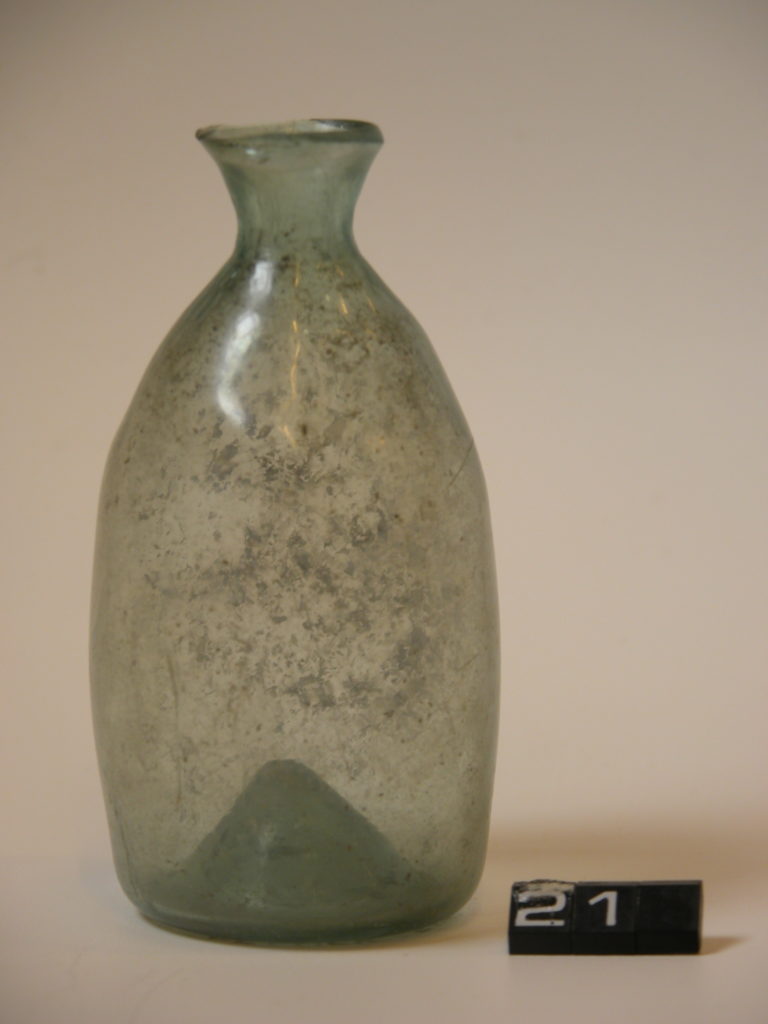
Roman bottle
Found during building of the extension to the 1899 Beaney Institute building in 1933. The extension was funded by the Slater family, with a purpose-built picture gallery on the first floor (now the People and Places room) and lecture hall on the ground floor (now part of the Library).
Reference: 6644
Can be found: BaseMaterials and Masters
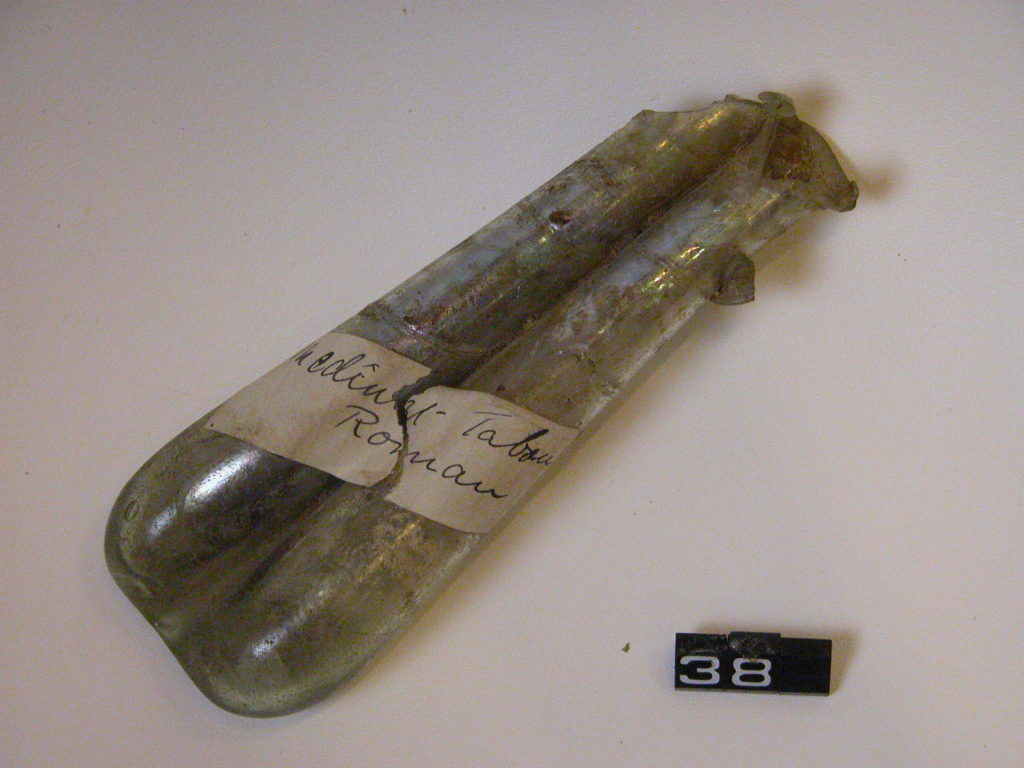
Roman bottles
These small bottles include many found during excavations in Canterbury. The double one has a label identifying it as found in Medinet-Tabou (Habou?) in Egypt. The bottles would have contained perfume, cosmetics, medicine and similar.
Reference: 6146, E11 and nn
Can be found: Lower shelfMaterials and Masters
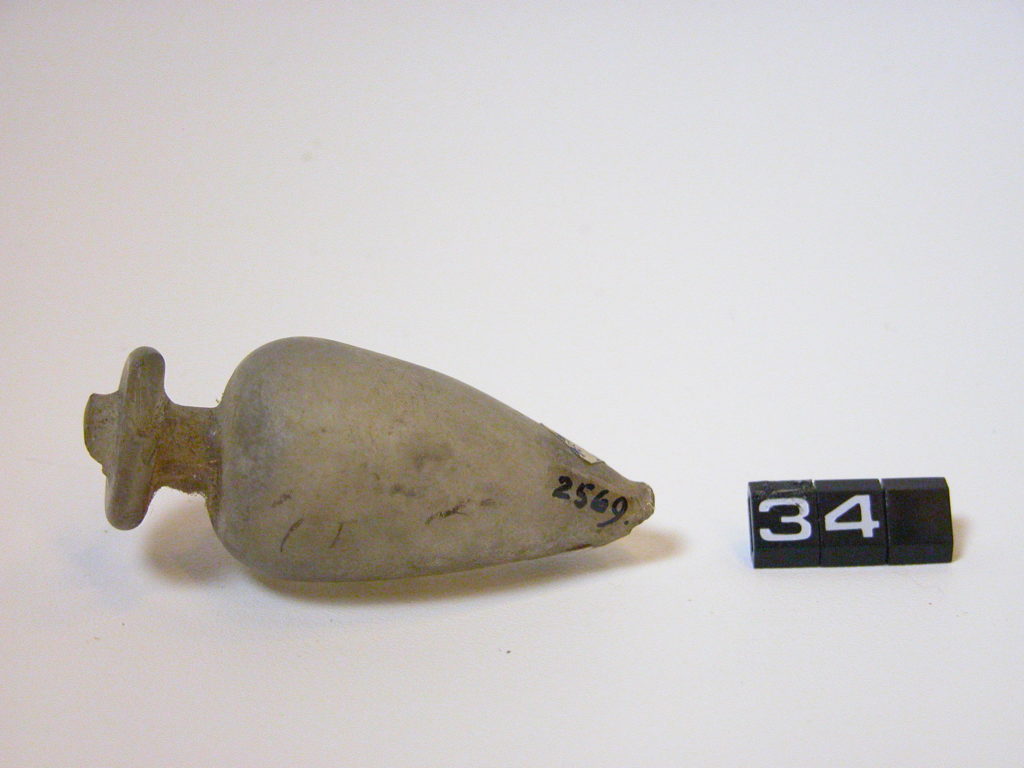
Roman bottles and fragments of stems
Reference: 2588, nn, 2569, 2556
Can be found: BaseMaterials and Masters
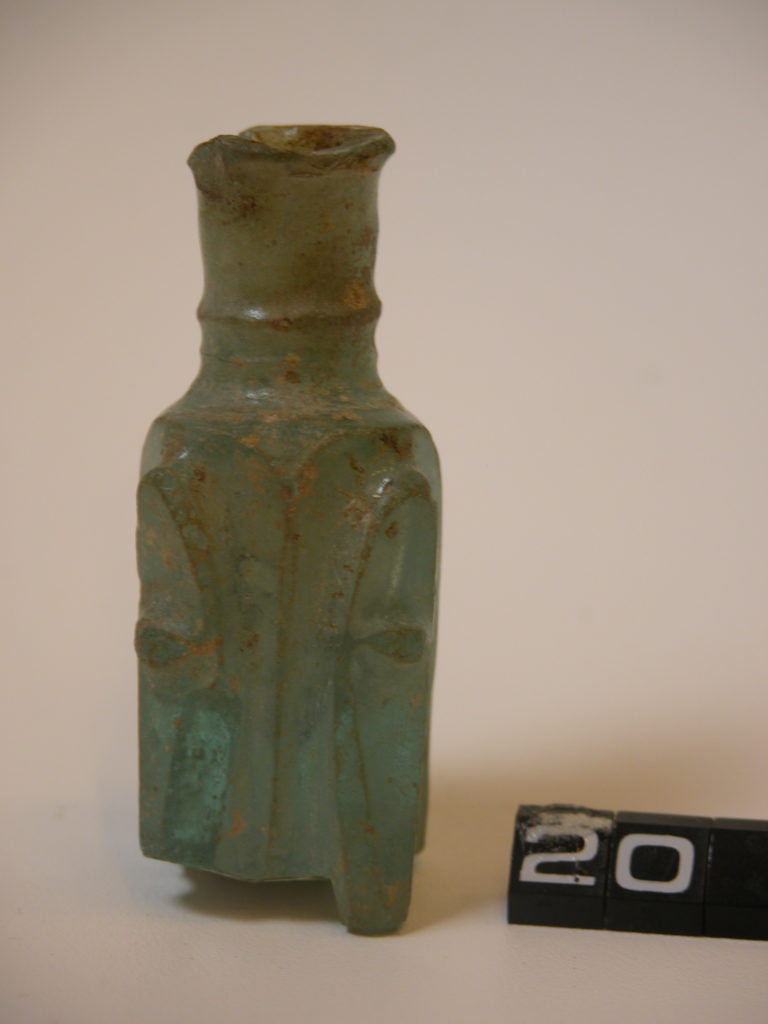
Roman green glass bottle with square body and cast or engraved pattern
Reference: 2541
Can be found: BaseMaterials and Masters
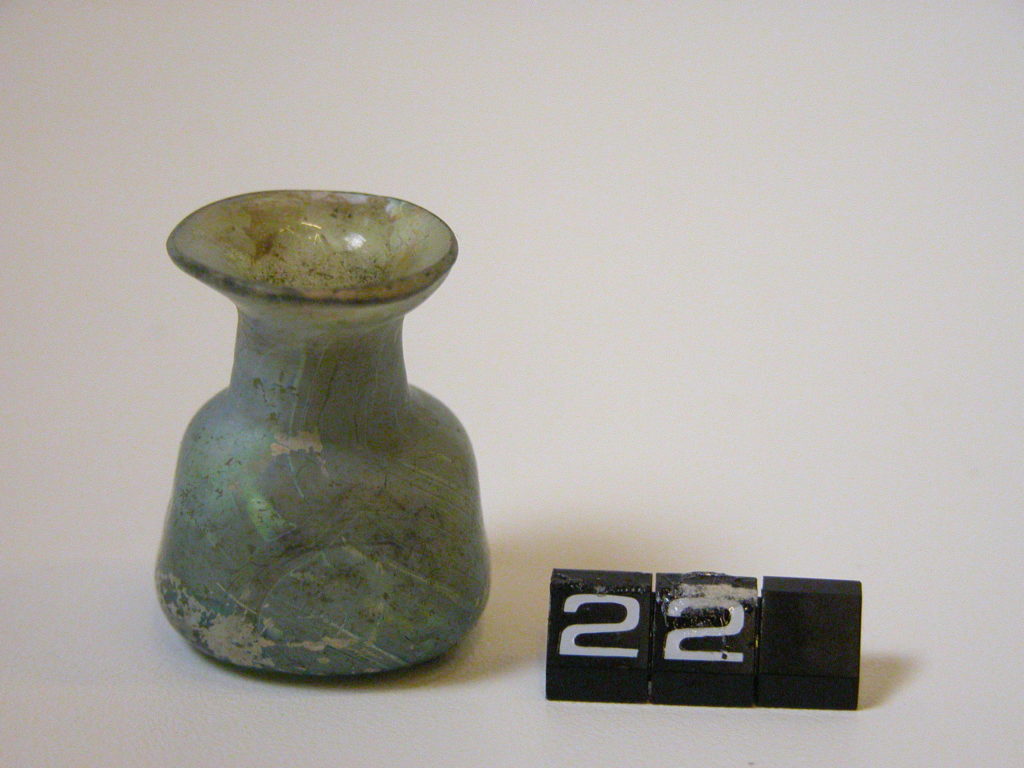
Roman green glass bottles
Reference: 2585, 2587
Can be found: BaseMaterials and Masters

Roman or later bottle and fragments of stems
Reference: nn, 2561, 2502, nn
Can be found: BaseMaterials and Masters
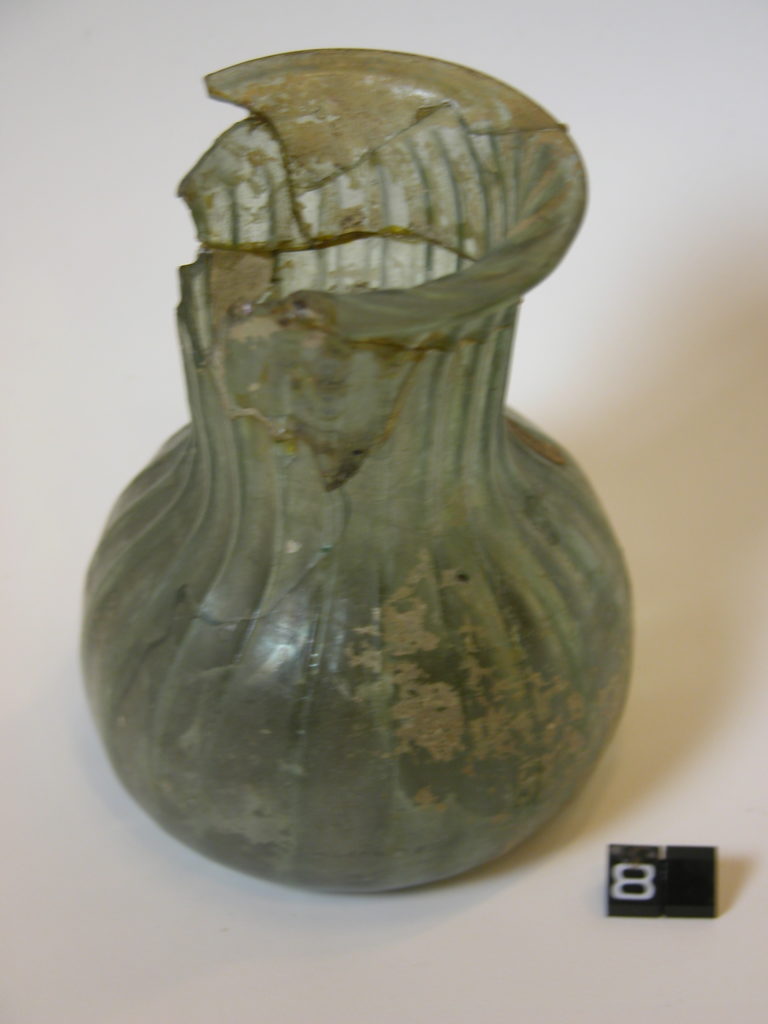
Roman vessel with ribbed sides and indented base
Bequeathed by John Brent
Reference: 2137
Can be found: BaseMaterials and Masters
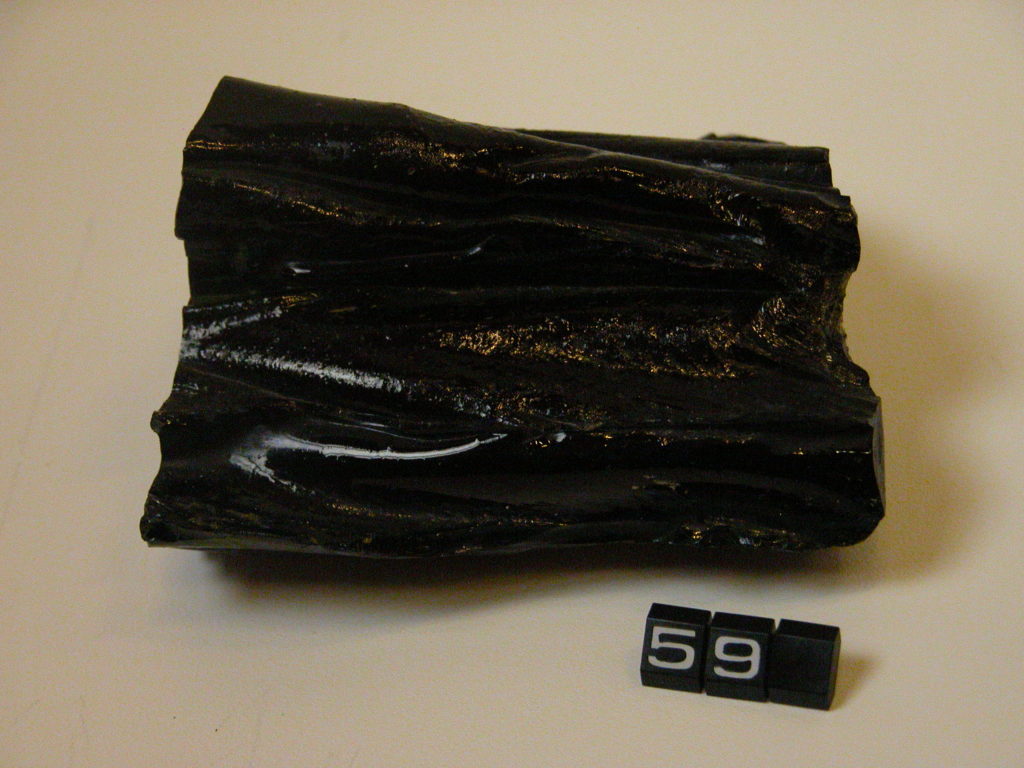
Ropy obsidian
Obsidian is a glassy rock formed through cooling of volcanic lava so fast that few crystals form. It can be black or green (like examples in Colour and Camouflage), and sometimes ropy, like this piece.
Reference: K 334
Can be found: Lower shelfMaterials and Masters
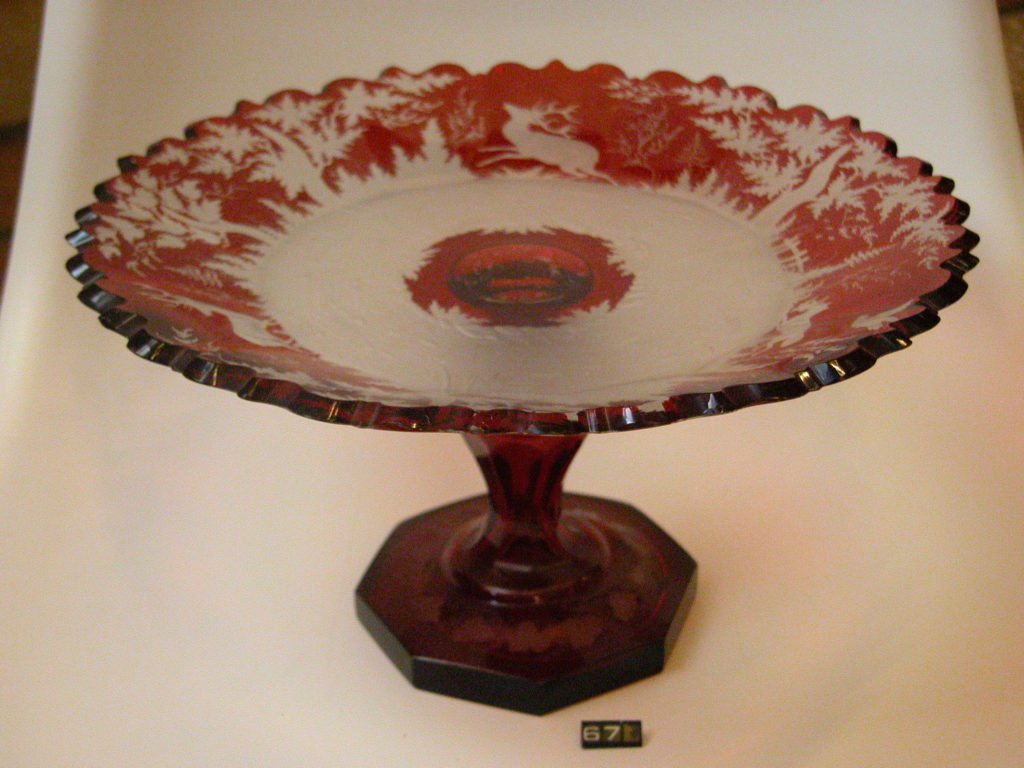
Ruby glass dishes with etched decoration
Glass can be coloured by the addition of minerals. Gold creates ruby-coloured glass.
Presented by Miss G Arrowsmith, from the collection of her late sister Miss G L Arrowsmith, 1992
Reference: 1992.38
Can be found: Materials and MastersTop shelf
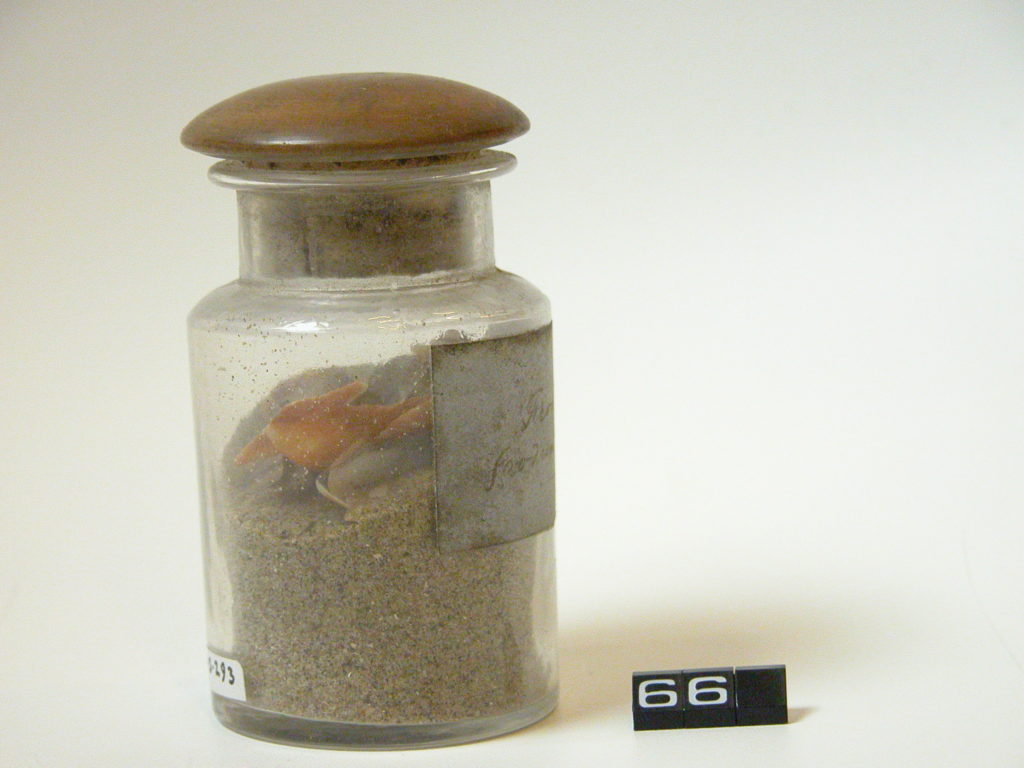
Sand in a jar
Sand is made of silica – glass.
From the collection of Rev V. P. Bowen
Reference: 1984.3.293
Can be found: Lower shelfMaterials and Masters

Selenite
Transparent Selenite is a variety of Gypsum, a hydrated calcium sulphate.
From the collection of Mr J. E. Cooper
Reference: 2004.148
Can be found: Lower shelfMaterials and Masters
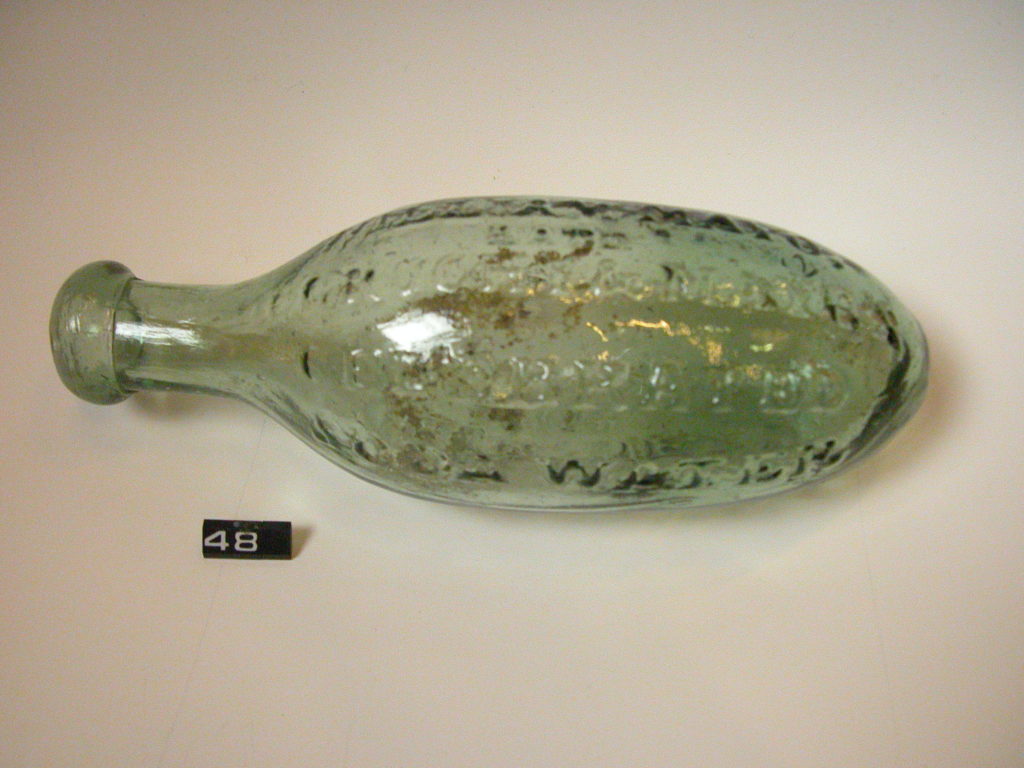
Soda water bottle
From the soda water supplier William Mayor of Silver Street, London.
Reference: CANCM:nn
Can be found: Centre shelfMaterials and Masters
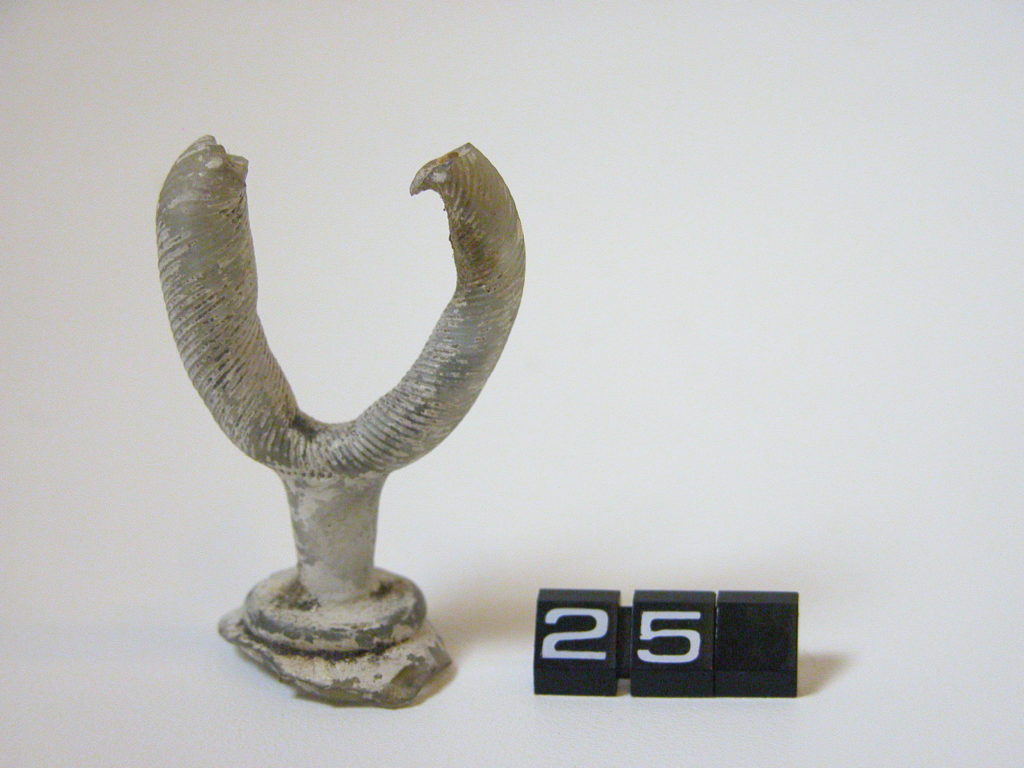
Stopper or dipper and decorative fragment
Reference: 2467, 7912
Can be found: BaseMaterials and Masters
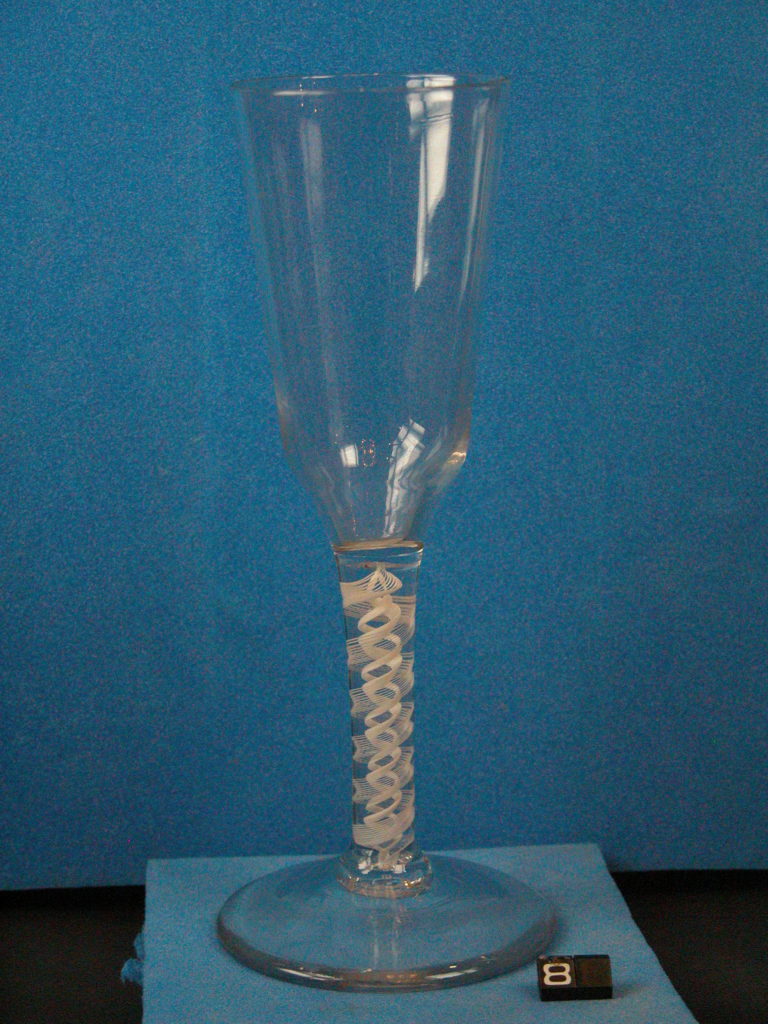
Tall wine glass
18th – 19th century
Plain bowl with an opaque twist stem.
Presented by Miss B Street from her brother’s collection, 1933
Reference: CANCM:nn
Can be found: Materials and MastersTop shelf
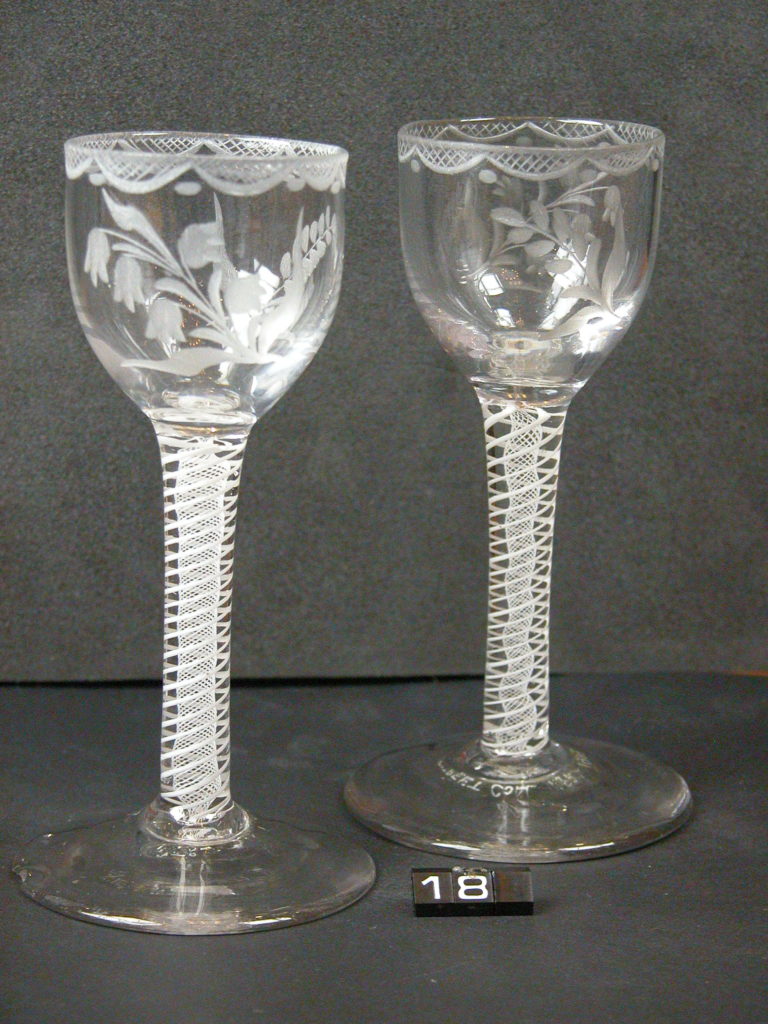
Two cordial glasses
18th – 19th century
With opaque twist stems and engraved with floral sprigs.
Presented by Miss B Street from her brother’s collection, 1933
Reference: CANCM:nn
Can be found: Materials and MastersTop shelf

Two Jacobite wine glasses 1745 – 60
Engraved with Jacobite roses, one also with a butterfly. Both have air twist stems, one of them ‘knopped’ with thicker blobs of glass. The air twist stems are created by trapping a bubble of air in molten glass then pulling and twisting as it cools.
Presented by Miss B Street from her brother’s collection, 1933
Reference: CANCM:nn
Can be found: Materials and MastersTop shelf
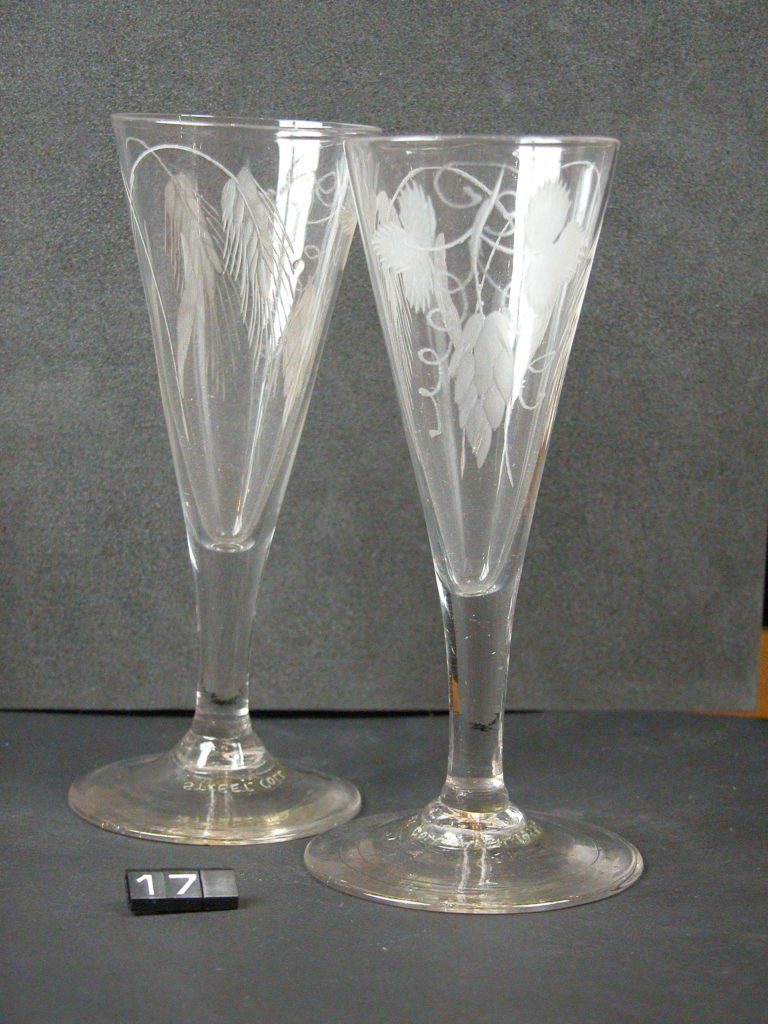
Two wine or ale glasses
18th – 19th century
Engraved decoration of barley and hops.
Presented by Miss B Street from her brother’s collection, 1933
Reference: CANCM:nn
Can be found: Materials and MastersTop shelf

Two wine or dessert glasses 18th – 19th century
With knopped stems, one with air bubbles trapped for decoration.
Presented by Miss B Street from her brother’s collection, 1933
Reference: CANCM:nn
Can be found: Materials and MastersTop shelf

Venus flower basket
The skeleton of an ocean sponge, known as Venus Flower Basket, is made of silica by the soft-bodied creature living inside. David Attenborough chose the Venus Flower Basket as one of the amazing creatures he would save if he had an ark, in a recent TV series.
Reference: CANCM:nn
Can be found: Lower shelfMaterials and Masters
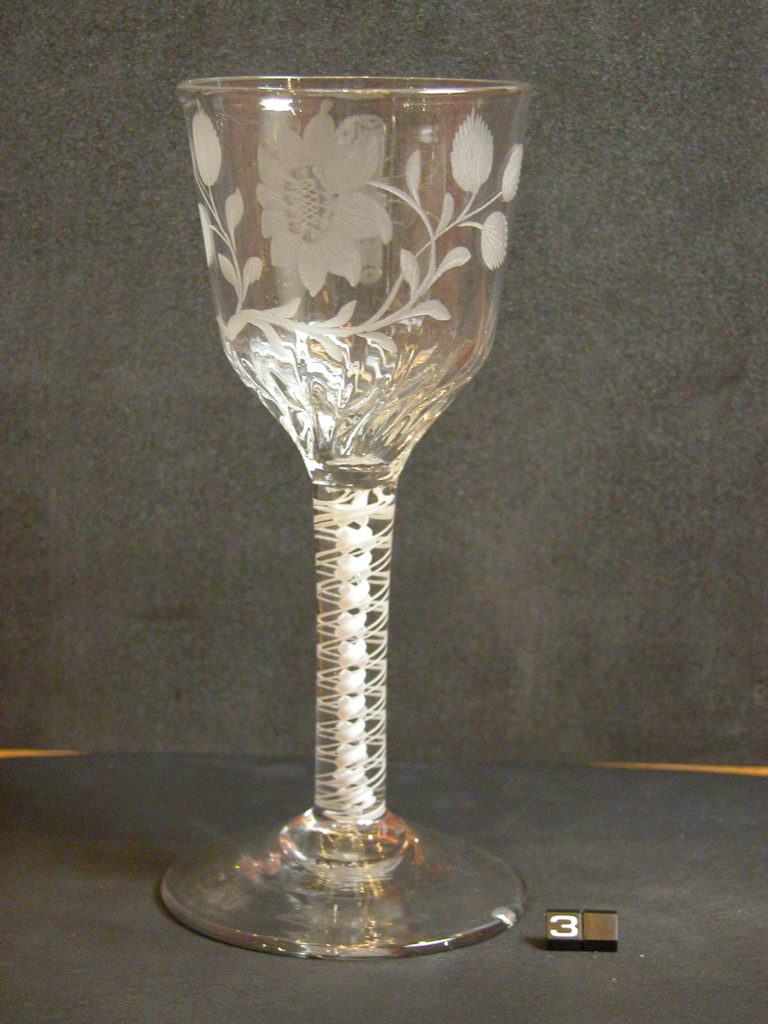
Wine glass
about 1750
With engraved decoration of flowers and a butterfly, and an opaque twist stem.
Bequeathed by John Irving, 1915
Reference: 5571
Can be found: Centre shelfMaterials and Masters
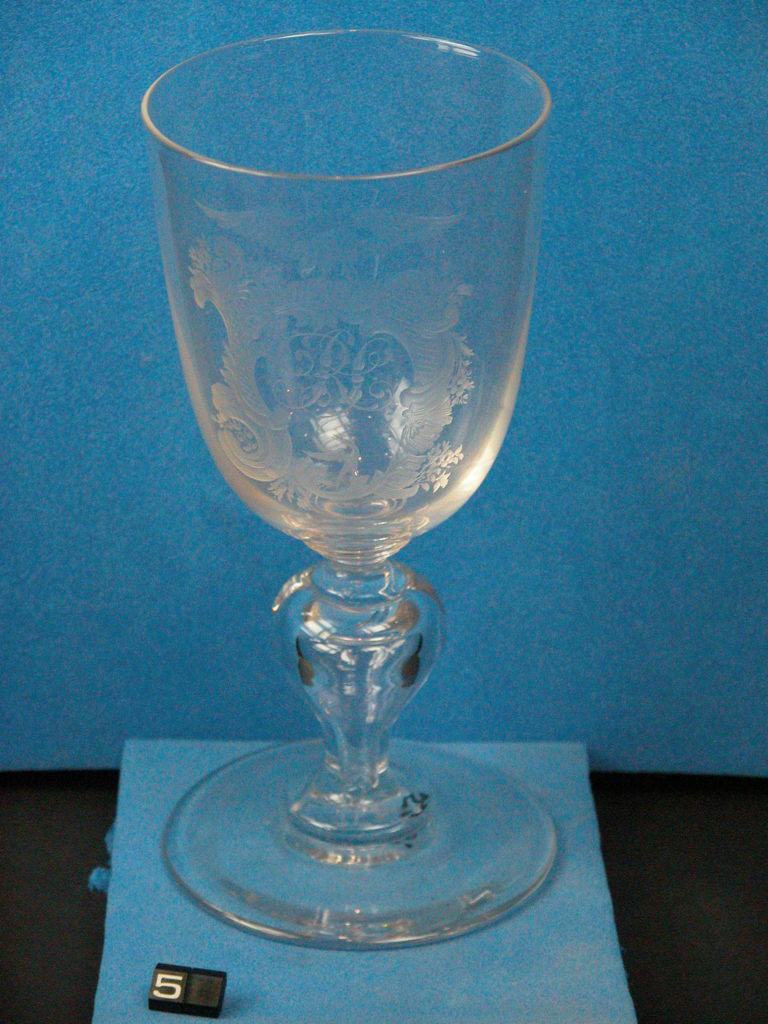
Wine glass
18th – 19th century
With a knopped stem and large bowl engraved with a coat of arms and initials.
Bequeathed by John Irving, 1915
Reference: 5581
Can be found: Centre shelfMaterials and Masters

Wine or ale glass
about 1745 – 70
With an air twist stem, the bowl is richly engraved with hops and barley.
Bequeathed by John Irving, 1915
Reference: 5574
Can be found: Centre shelfMaterials and Masters
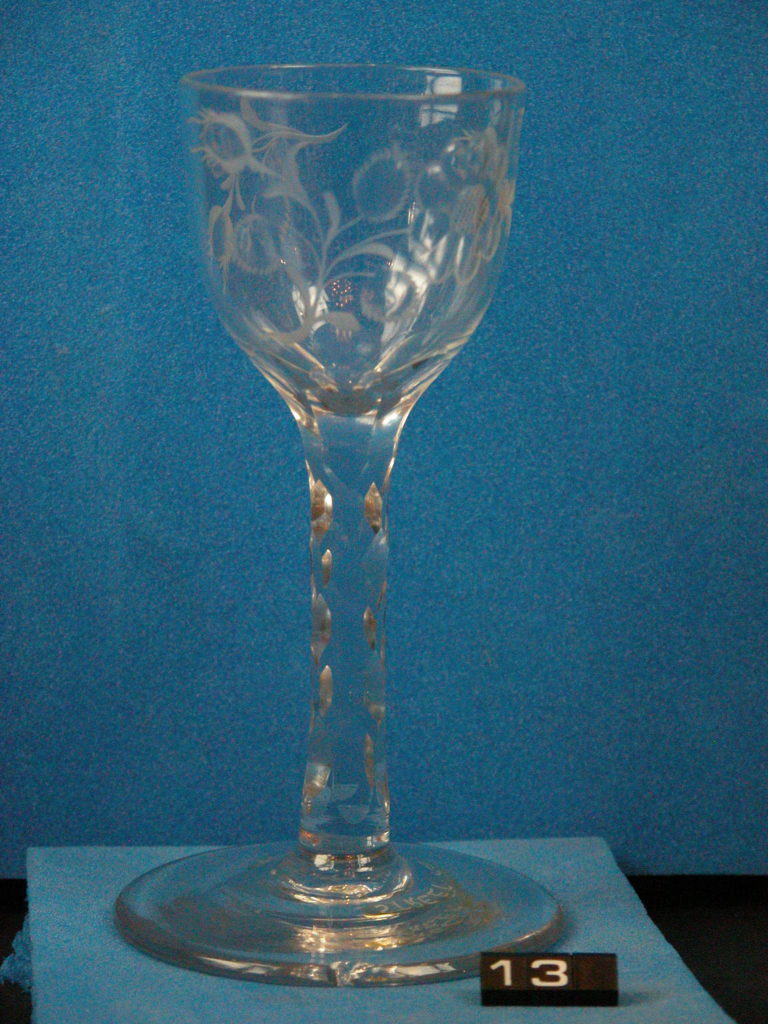
Wine or cordial glass
1760 – 1810
With a faceted stem, the bowl with dog rose pattern engraved.
Presented by Miss B Street from her brother’s collection, 1933
Reference: CANCM:nn
Can be found: Materials and MastersTop shelf

